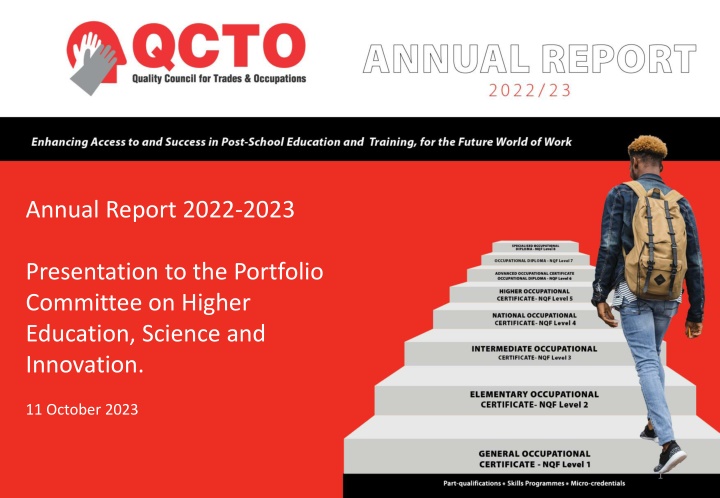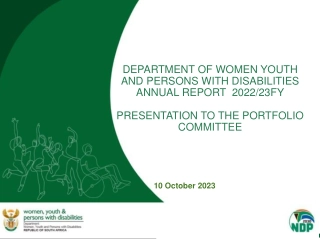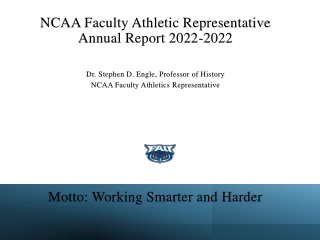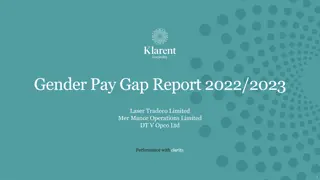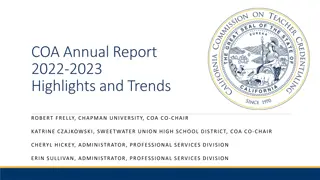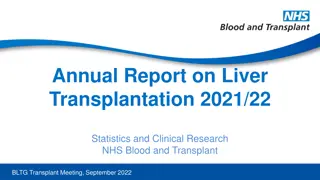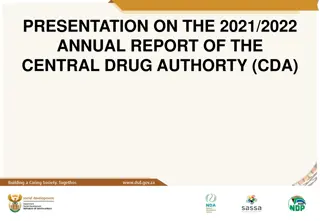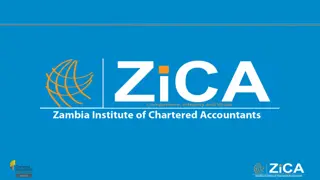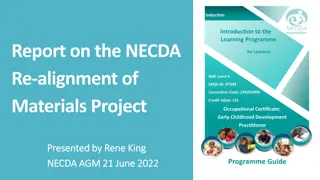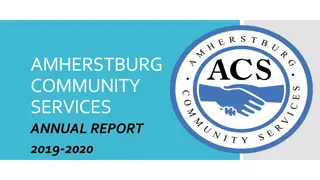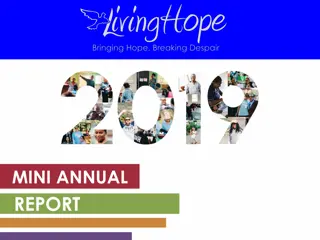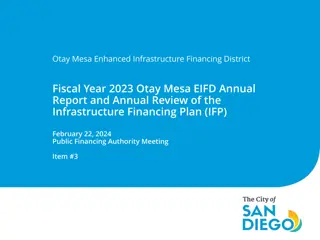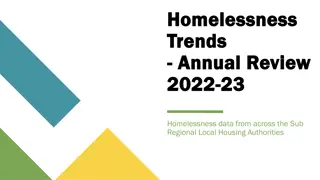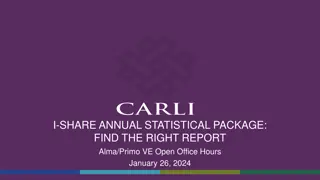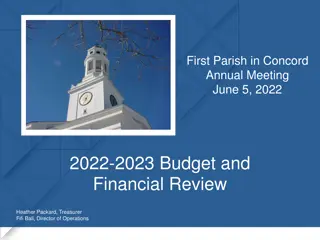QCTO Annual Report 2022-2023 Presentation Highlights
Presentation highlights from the QCTO Annual Report 2022-2023 to the Portfolio Committee on Higher Education, Science, and Innovation. The presentation covers the Chairperson's remarks on enhancing access to and success in post-school education, aligning with the QCTO's vision, Strategic Plan, and National Plan for Post-School Education and Training. It also discusses the QCTO's achievements, governance structure, senior management team, and funding challenges affecting its potential in the PSET sector.
Download Presentation

Please find below an Image/Link to download the presentation.
The content on the website is provided AS IS for your information and personal use only. It may not be sold, licensed, or shared on other websites without obtaining consent from the author.If you encounter any issues during the download, it is possible that the publisher has removed the file from their server.
You are allowed to download the files provided on this website for personal or commercial use, subject to the condition that they are used lawfully. All files are the property of their respective owners.
The content on the website is provided AS IS for your information and personal use only. It may not be sold, licensed, or shared on other websites without obtaining consent from the author.
E N D
Presentation Transcript
Annual Report 2022-2023 Presentation to the Portfolio Committee on Higher Education, Science and Innovation. 11 October 2023 1
Chairpersons Remarks Chairpersons Remarks Enhancing Access to and Success in Post-School Education and Training, for the Future World of Work. 2
Chairpersons Remarks Chairpersons Remarks This theme resonates with: the Vision of the QCTO : to qualify a skilled and capable workforce. the imperatives of the MTSF (2019-2014) with respect to improving TVET provisioning The Strategic Plan (2020/21 to 2024/25) of the DHET with its emphasis on the a more responsive PSET system (expanded access, improved success, efficiency and quality of PSET provisioning) recommendations contained in the National Plan for Post-School Education and Training (2021-2030) 3
Chairpersons Remarks Chairpersons Remarks The theme not only declares the intention of the QCTO, but is reflected in the work and achievements of the QCTO for the 2022 -2023 reporting period: Achieving its 7th consecutive clean audit. Achieving 93% (26 out of 28) of its performance targets (77% in 2021-2022) Advocacy and Implementation of the OQSF Increased Qualifications development Implementation of Skills Programmes to address the unemployment challenges as well as upskilling and reskilling of current workforce. Increased Accreditation of Public TVET and CET Colleges. 4
Governance Structure Governance Structure 5
Senior Management Structure Senior Management Structure Mr. Themba Dlamini Council Chairperson (Appointed 10 November 2022) Mr. V Naidoo Chief Executive Officer (Re-appointed 1 June 2022) Mr. Khathutshelo Maposa Chief Financial Officer Mr. T Lata Chief Director: Occupational Qualifications Management Ms. N Madilonga- Khondowe Chief Director Corporate Services Mr. E Mbuwe Chief Director: Occupational Quality Assurance (Appointed 1 April 2023) 6
Chairpersons Remarks Chairpersons Remarks Funding regime of the QCTO Realising the full potential of the QCTO in the PSET sector remains constrained by the current funding model. Main Source of funding remains at 0,5% in terms of the Skills Grant Regulations. For 2022-23 the QCTO applied for R163million but was only granted an amount was R96 147million. Fiscal Grant from the DHET for 2022-23 (R28 506m) The Draft SETA Grant Regulations recommends a 1% allocation to SETAs. QCTO eagerly awaits the approval of the Regulations. The NSDP 2030 also indicates that the QCTO funding will be reviewed to enable the QCTO to fully execute its mandate. Funding model needs urgent attention especially in view of the expanding mandate of the QCTO w.r.t. the work being done with TVET and CET Colleges. 7
Overview Overviewby the Chief Executive Officer by the Chief Executive Officer The theme of the Annual Report 2022-2023 underpinned the activities undertaken by the QCTO. These were achieved by: Implementation of risk-based quality assurance mechanisms (due to funding limitations) Promoting a standardised national quality assurance framework Implementing the OQSF (Game Changer in the PSET Sector) Implementing Vision 2027 in collaboration with Quality Partners (SETA s). Vision 2027 outlines how the QCTO will work in conjunction with the SETAs based on the current funding model. 8
Overview Overviewby the Chief Executive Officer by the Chief Executive Officer Steep increase in the uptake of Occupational Qualifications especially in the public TVET and CET Colleges (expanded mandate of the QCTO) made possible through the easing of the funded programmes (PQM) of the Colleges as well as the phasing out of the N1-N3 NATED Programmes. Increase in number of TVET and CET Colleges accredited to offer Skills Programmes. Fostering International engagements and partnerships. The QCTO continues to implement (as a pilot) a hybrid model of work on a rotational basis with a 70:30 ratio (office: home) All staff supplied with requisite tools of trade. 9
Overview by the Chief Executive Officer Overview by the Chief Executive Officer Approval of QCTO Business Case QCTO Business Case not approved now subsumed into the process to ensure that the QCTO is allocated 1% of the SETA Grant. QCTO was only able to meet the third milestone of Transition to QCTO Supervision Vision 2020 (by implication consideration of the Business Case) culminated with an agreement that QCTO enter into SLAs to standardise the models of Quality Assurance as well as the policy framework across the sector. Such decision was reached in 2019 after protracted deliberation with the DHET, SETA s and the QCTO. SETAs were requested by DHET to ensure a line item for quality assurance in their budgets. 10
Vision 2020 Vision 2020 - - Intended Plan Intended Plan 11
Simplification of the QCTOs operating model Simplification of the QCTO s operating model Activities that contribute to quality assurance devolved to Quality Partners (QP s) through MoUs or SLAs. Model is based on local and international best practice in the management of Quality Councils or bodies similar to the QCTO. The QPs that will be conducting direct quality assurance functions (quality control) on behalf of the QCTO are Sector Education and Training Authorities (SETAs). SETAs have the specialist expertise through their chambers and links with industry. Accountability for quality assurance is vested in the QCTO. 12
Service Delivery Environment Service Delivery Environment Implementation of the Ministerial Determination on the Sub-frameworks National Development Plan 2030 MTSF 2019 2024 National Skills Development Plan 2030 Reviewed Strategic Plan of the DHET ERRSS and IPAP Implementing Vision 2027 13
Measuring Performance Measuring Performance Impact Statement: To ensure a skilled and capable workforce that is employable or self-employed , through ensuring the development of relevant qualifications, part qualifications and skilled programmes , ensuring the quality of provisioning and assessment and issuing certificates to qualifying candidates. Maintaininga single national quality assured Occupational Qualifications Sub-Framework (OQSF) that promotes synergy, simplification and effectiveness Outcome 1 Ensuringthe development and quality assurance of occupational qualifications, part qualifications and skills programmes are responsive to labour market and developmental state initiatives Outcome 2 Creating a QCTO that is a responsive learning organisation Outcome 3 14
Programme 1: Administration Programme 1: Administration STRATEGY TO OVERCOME AREAS OF PROGRAMME PURPOSE: To enable QCTO performance through strategic leadership and reliable delivery of management support services that will ensure a responsive and learning (Contributes to Outcome 3) 3 out of 4 targets achieved UNDER PERFORMANCE Target 1.2.1 was not achieved (72% achieved - Deviation 28%) Completion of some of the planned projects in the MSP Annual Plan 2022/23 were impacted by unexpected internal systematic delays, e.g. re-advertisement of tenders due to unresponsive bids and cancellation of one tender. The said projects have been prioritised for completion in Q1/Q2 of the 2023/2024 financial year 15
Programme 1: Administration Programme 1: Administration 16
Programme 2: Occupational Qualifications Programme 2: Occupational Qualifications Management, Assessment and Certification Management, Assessment and Certification PROGRAMME PURPOSE ACHIEVEMENTS Qualifications and Skills programmes guided by ERRSS 54 Occupational Qualifications in the reporting period resulting in more than 704 Occupational Qualifications now registered on the NQF. 118 Skills Programmes approved by QCTO 221 Historically Registered Qualifications recommended to SAQA for deactivation. 100% achievements on Assessment of Occupational Qualifications ( 112 EISAs conducted in 2022/23 compared with 40 in 2021/22 2451 Occupational Certificates issued in 2022/23 compared to 1395 in 2021/2022 21568 issued in 2022/23 compared with 16 338 in 2021/2022 114 Skills Programme Certificates issued in 2022/23 13 757 certificate verified compared with 10 124 2021/2022 To ensure that occupational qualifications, part-qualifications and skills programmes on the OQSF are developed and registered on the NQF A national Assessment (EISA) implemented for all qualifications on the OQSF. Issue certificates to qualifying learners; verify the authenticity of issued certificates (Contributes to Outcome 1) 10 out of 10 targets achieved 17
Strategy to overcome areas of under Strategy to overcome areas of under performance performance The following strategy will be put in place to address areas of underperformance: Develop and implement a plan to increase the Deregistration and/or reregistration of historically registered qualifications; Developing and reviewing occupational qualifications listed in the ERRSS; Continue to automate the skills programme application process; Continue with advocacy workshops on skills programmes. These workshops will assist in communicating to stakeholders the skills programmes requirements and provide an opportunity to listen to and address stakeholder needs; Maintain achieving the certification targets, which include the digitisation project Monitor the certificates issued by SETAs/ QPs; and Ensure EISAs conducted are monitored through the entire value chain from EISA readiness up to resulting. 26
Programme 3: Occupational Qualifications Programme 3: Occupational Qualifications Quality Assurance Quality Assurance PROGRAMME PURPOSE To establish and maintain quality standards for Accreditation and Assessment (Administration) within the OQSF 1. Establish and maintain standards for a national quality assurance system for all qualifications registered on the OQSF. 2. Establish and maintain standards for a national Accreditation System for all qualifications registered on the OQSF. 3. Monitor uptake of Occupational qualifications and Skills Programmes by TVET Colleges, CET Colleges, Universities and Private Skills Development Providers (Contributes to Outcome 1 & 2) 11 of 12 targets achieved ACHIEVEMENTS 1622 SDP accreditation applications for Occupational qualifications processed in 2022/23 compared with 911 in 2021/2022 179 SDP accreditation applications for Skills Programmes processed in 2022/23 compared with 90 in 2021/2022 179 SDP accreditation applications for Skills Programmes processed in 2022/23 compared with 90 in 2021/2022 1178 SDP accreditation applications for Historically Registered qualifications processed in 2022/23 compared with 934 in 2021/2022 371 Assessment Centre accreditation applications processed in 2022/23 compared with 254 in 2021/2022 204 accredited SDPs quality assured in 2022/23 compared with 123 in 2021/2022 27
Strategy to overcome areas of under Strategy to overcome areas of under performance performance Accredited Skills Development Providers will be contacted every month to find out if they have learners enrolled. The QCTO will continue to strengthen relationships and communication with the QPs and related stakeholders to enable a meaningful and seamless transition to the new occupations. The QCTO-SETA forum is being resuscitated as a Quality Partner Forum, which will focus on OQSF policy implementation as well as ERRSS implementation. The QCTO has started to implement the necessary control processes to manage the upload of learner achievements to the NLRD. Upskilling of employees and process improvements has been prioritised to improve overall efficiency. 40
Programme 4: Research and Analysis Programme 4: Research and Analysis ACHIEVEMENTS Indicators 4.1.1 and 4.1.2 fully achieved. Publication of Benchmarking report on Comparison of OQSF against 5 Frameworks: The Australian Qualifications Framework (AQF) The Bangladeshi National Technical and Vocational Qualifications Framework (NTVQF) The Dutch Qualifications Framework (NLQF) The National Qualifications Framework (NQF) for Namibia The Scottish Qualifications Framework (SQF) PROGRAMME PURPOSE To establish and maintain QCTO Standards for quality assurance through research, monitoring, evaluation and analysis. (Contributes to Outcome 1) OQSF compares favourably against other sub-frameworks 41
Programme 4: Research Analysis Programme 4: Research Analysis PROGRAMME 4: RESEARCH ANALYSIS & QUALITY ASSURANCE OUTCOME OUTPUT OUTPUT INDICATOR AUDITED ACTUAL PERFORMANCE 2020/21 AUDITED ACTUAL PERFORMANCE 2021/22 PLANNED ANNUAL TARGET 2022/23 ACTUAL ACHIEVMENT 2022/23 DEVIATION FROM PLANNED ACHIEVMENT REASONS FOR DEVIATIONS 4.1 Research on issues of importance to the development and implementation of the OQSF conducted, commissioned or published 4.1.1 Number of Research Reports approved by the CEO New Indicator Achieved 3 Achieved 100% 3 of 3 reports were completed and approved by the CEO N/A N/A A single national quality assured Occupational Qualifications Sub-Framework that promotes synergy, simplification & effectiveness Achieved 3 3 Submissions signed by the CEO approving 3 final reports Submissions signed by the CEO approving 3 final reports 4.1.2 Research Bulletin published online New Indicator Achieved 1 Achieved 100% 1 Research Bulletin published online N/A N/A Achieved 1 1 Signed website publication form Signed website publication form 42
Human Resource Oversight Statistics Human Resource Oversight Statistics 43
Human Resource Oversight Statistics Human Resource Oversight Statistics 44
Human Resource Oversight Statistics Human Resource Oversight Statistics 45
Human Resource Oversight Statistics Human Resource Oversight Statistics 46
Audit outcomes overview Audit outcomes overview Annual Financial Statements No Material Findings Predetermined Objectives No Findings Compliance with Legislation No Findings Internal Controls No deficiencies identified Seventh Consecutive Clean Audit Outcome ( 9th in 10 years) No Irregular, unauthorized and Fruitless &wasteful Expenditures incurred 47
4. Revenue collection 4. Revenue collection 48
Statement of Financial Performance Statement of Financial Performance 49
Statement of Financial Position Statement of Financial Position 50
